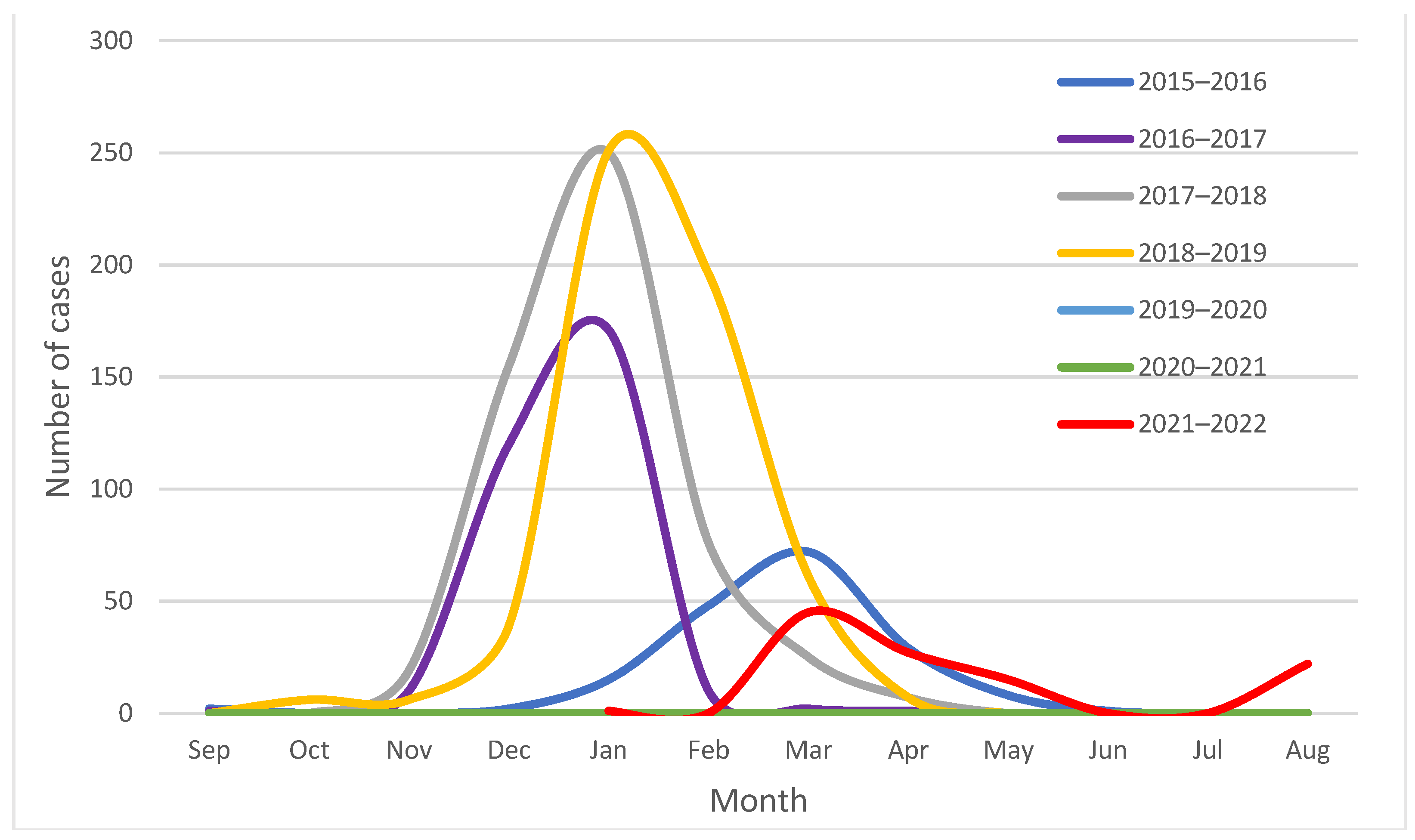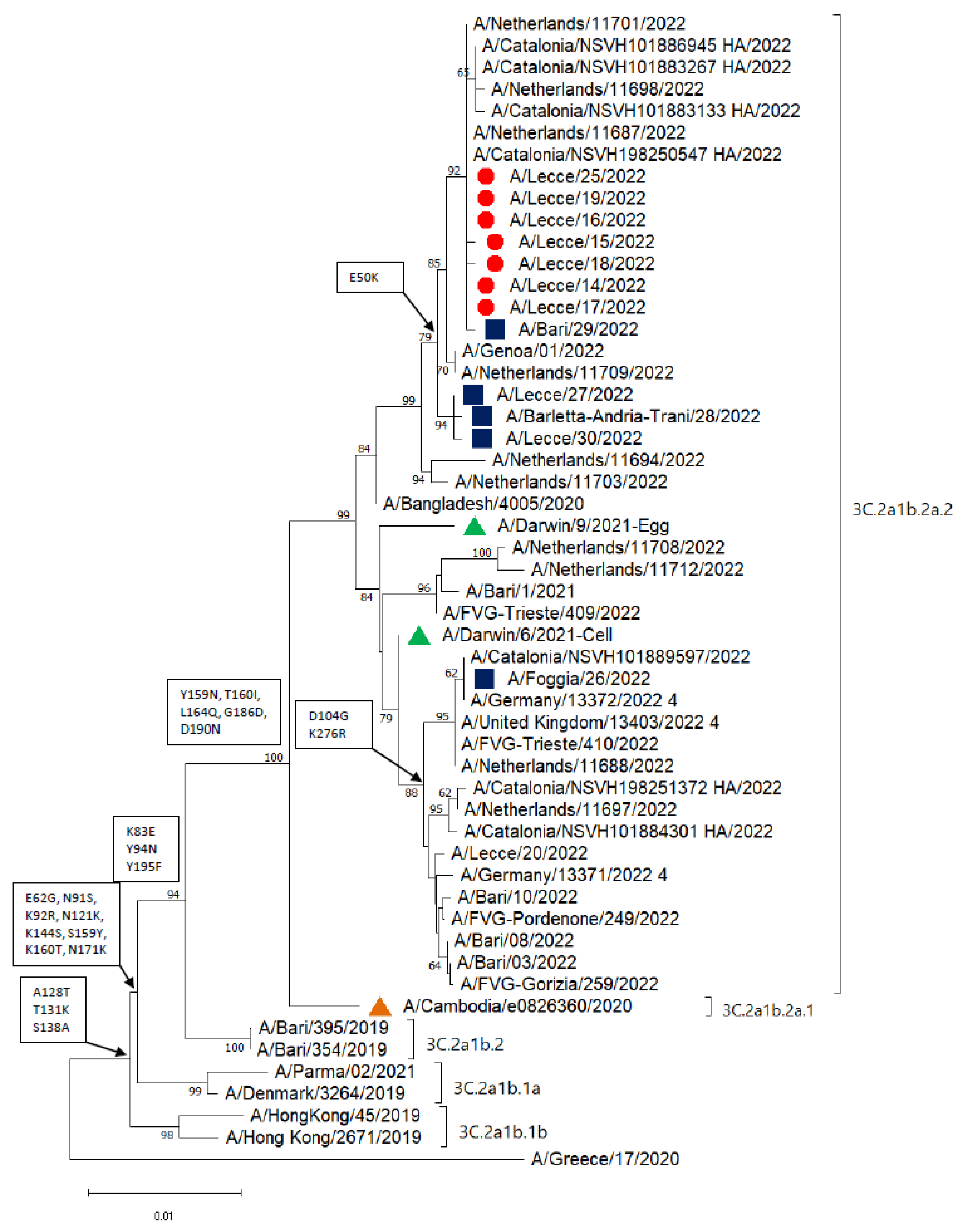What’s Next for Flu? Out-of-Season Circulation of Influenza Viruses in Southern Italy, August 2022
Abstract
1. Introduction
2. Materials and Methods
2.1. Subject Enrollment
2.2. Molecular Identification and Sequencing of Influenza Viruses
2.3. Ethical Statement
3. Results
4. Discussion
5. Conclusions
Author Contributions
Funding
Institutional Review Board Statement
Informed Consent Statement
Data Availability Statement
Acknowledgments
Conflicts of Interest
References
- World Health Organization. Vaccines against Influenza: WHO Position Paper—May 2022. Available online: https://www.who.int/publications/i/item/who-wer9719 (accessed on 23 August 2022).
- Fowlkes, A.; Steffens, A.; Temte, J.; Lonardo, S.D.; McHugh, L.; Martin, K.; Rubino, H.; Feist, M.; Davis, C.; Selzer, C.; et al. Influenza Incidence Surveillance Project Working Group. Incidence of medically attended influenza during pandemic and post-pandemic seasons through the Influenza Incidence Surveillance Project, 2009–2013. Lancet Respir. Med. 2015, 3, 709–718. [Google Scholar] [CrossRef] [PubMed][Green Version]
- World Health Organization. Influenza (Seasonal). Available online: https://www.who.int/news-room/fact-sheets/detail/influenza-(seasonal) (accessed on 24 August 2022).
- Iuliano, A.D.; Roguski, K.M.; Chang, H.H.; Muscatello, D.J.; Palekar, R.; Tempia, S.; Cohen, C.; Gran, J.M.; Schanzer, D.; Cowling, B.J.; et al. Global Seasonal Influenza-associated Mortality Collaborator Network. Estimates of global seasonal influenza-associated respiratory mortality: A modelling study. Lancet 2018, 391, 1285–1300, Erratum in Lancet 2018, 391, 1262. [Google Scholar] [CrossRef] [PubMed]
- World Health Organization. Influenza and Influenza Vaccines: A Background Document for the Strategic Advisory Group of Experts (SAGE) on Immunization from the SAGE Working Group on Influenza. Geneva, 2021. Available online: www.who.int/news-room/events/detail/2021/10/04/default-calendar/sage_meeting_october_2021 (accessed on 24 August 2022).
- Giacchetta, I.; Primieri, C.; Cavalieri, R.; Domnich, A.; de Waure, C. The burden of seasonal influenza in Italy: A systematic review of influenza-related complications, hospitalizations, and mortality. Influenza Other Respir. Viruses 2022, 16, 351–365. [Google Scholar] [CrossRef] [PubMed]
- Epicentro. Picentro. Sistema di Sorveglianza Integrata dell’Influenza. Available online: https://w3.iss.it/site/RMI/influnet/pagine/stagioni.aspx (accessed on 24 November 2022).
- Tang, J.W.; Bialasiewicz, S.; Dwyer, D.E.; Dilcher, M.; Tellier, R.; Taylor, J.; Hua, H.; Jennings, L.; Kok, J.; Levy, A.; et al. Where have all the viruses gone? Disappearance of seasonal respiratory viruses during the COVID-19 pandemic. J. Med. Virol. 2021, 93, 4099–4101. [Google Scholar] [CrossRef]
- Mansuy, J.M.; Bourcier, M.; Trémeaux, P.; Dimeglio, C.; Izopet, J. COVID-19 pandemic period, where are the seasonal viruses? J. Med. Virol. 2021, 93, 4097–4098. [Google Scholar] [CrossRef]
- Sanz-Muñoz, I.; Tamames-Gómez, S.; Castrodeza-Sanz, J.; Eiros-Bouza, J.M.; de Lejarazu-Leonardo, R.O. Social Distancing, Lockdown and the Wide Use of Mask; A Magic Solution or a Double-Edged Sword for Respiratory Viruses Epidemiology? Vaccines 2021, 9, 595. [Google Scholar] [CrossRef]
- Nickbakhsh, S.; Mair, C.; Matthews, L.; Reeve, R.; Johnson, P.C.D.; Thorburn, F.; von Wissmann, B.; Reynolds, A.; McMenamin, J.; Gunson, R.N.; et al. Virus-virus interactions impact the population dynamics of influenza and the common cold. Proc. Natl. Acad. Sci. USA 2019, 116, 27142–27150. [Google Scholar] [CrossRef]
- Li, Y.; Wang, X.; Msosa, T.; de Wit, F.; Murdock, J.; Nair, H. The impact of the 2009 influenza pandemic on the seasonality of human respiratory syncytial virus: A systematic analysis. Influenza Other Respir. Viruses 2021, 15, 804–812. [Google Scholar] [CrossRef]
- Olsen, S.J.; Winn, A.K.; Budd, A.P.; Prill, M.M.; Steel, J.; Midgley, C.M.; Kniss, K.; Burns, E.; Rowe, T.; Foust, A.; et al. Changes in Influenza and Other Respiratory Virus Activity During the COVID-19 Pandemic—United States, 2020–2021. MMWR Morb. Mortal. Weekly Rep. 2021, 70, 1013–1019. [Google Scholar] [CrossRef]
- Abou El Naja, H.; Tempia, S.; Barakat, A.; Elkholy, A.; Aman, A.; Khan, W.; Abubakar, A. Influenza activity in the Eastern Mediterranean Region (EMR) in 2020–2021 amidst the COVID-19 pandemic. BMJ Glob. Health 2022, 7 (Suppl. 4), e008506. [Google Scholar] [CrossRef]
- Sberna, G.; Lalle, E.; Valli, M.B.; Bordi, L.; Garbuglia, A.R.; Amendola, A. Changes in the Circulation of Common Respiratory Pathogens among Hospitalized Patients with Influenza-like Illnesses in the Lazio Region (Italy) during Fall Season of the Past Three Years. Int. J. Environ. Res. Public Health 2022, 19, 5962. [Google Scholar] [CrossRef] [PubMed]
- European Centre for Disease Prevention and Control. Flu News Europe. Season Overview, 2021–2022 Season. Available online: https://flunewseurope.org/SeasonOverview (accessed on 24 August 2022).
- Centers for Disease Control and Prevention. Weekly U.S. Influenza Surveillance Report. Available online: https://www.cdc.gov/flu/weekly/ (accessed on 24 August 2022).
- InfluNet. Rete Italiana Sorveglianza Influenza. Rapporto Epidemiologico N. 26 del 8 Maggio 2022. Available online: https://w3.iss.it/site/rmi/influnet/pagine/rapportoinflunet.aspx (accessed on 24 August 2022).
- InfluNet&CovidNet. Protocollo Operative Stagione 2021–2022. Sistema di Sorveglianza Sentinella delle Sindromi Similinfluenzali, dei virus Influenzali e del Virus SARS-CoV-2. Available online: https://www.epicentro.iss.it/influenza/pdf/Protocollo-Influnet-2020-2021.pdf (accessed on 30 November 2022).
- Loconsole, D.; De Robertis, A.L.; Morea, A.; Casulli, D.; Mallamaci, R.; Baldacci, S.; Centrone, F.; Bruno, V.; Quarto, M.; Accogli, M.; et al. High Public-Health Impact in an Influenza-B-Mismatch Season in Southern Italy, 2017–2018. Biomed. Res. Int. 2019, 2019, 4643260. [Google Scholar] [CrossRef] [PubMed]
- World Health Organization (WHO). WHO Information for the Molecular Detection of Influenza Viruses. 2021. Available online: https://cdn.who.int/media/docs/default-source/influenza/molecular-detention-of-influenza-viruses/protocols_influenza_virus_detection_feb_2021.pdf?sfvrsn=df7d268a_5 (accessed on 8 September 2022).
- Sunagawa, S.; Iha, Y.; Taira, K.; Okano, S.; Kinjo, T.; Higa, F.; Kuba, K.; Tateyama, M.; Nakamura, K.; Nakamura, S.; et al. An Epidemiological Analysis of Summer Influenza Epidemics in Okinawa. Intern. Med. 2016, 55, 3579–3584. [Google Scholar] [CrossRef] [PubMed]
- Epicentro. FluNews Italia: Archivio. Available online: https://www.epicentro.iss.it/influenza/FluNewsArchivio (accessed on 31 August 2022).
- Nott, R.; Fuller, T.L.; Brasil, P.; Nielsen-Saines, K. Out-of-Season Influenza during a COVID-19 Void in the State of Rio de Janeiro, Brazil: Temperature Matters. Vaccines 2022, 10, 821. [Google Scholar] [CrossRef] [PubMed]
- Grohskopf, L.A.; Blanton, L.H.; Ferdinands, J.M.; Chung, J.R.; Broder, K.R.; Talbot, H.K.; Morgan, R.L.; Fry, A.M. Prevention and Control of Seasonal Influenza with Vaccines: Recommendations of the Advisory Committee on Immunization Practices—United States, 2022–2023 Influenza Season. MMWR Recomm. Rep. 2022, 71, 1–28. [Google Scholar] [CrossRef]
- Epicentro; Istituto Superiore di Sanità. Coperture della Vaccinazione Antinfluenzale in Italia. Available online: https://www.epicentro.iss.it/influenza/coperture-vaccinali (accessed on 23 August 2022).
- Rizzo, C.; Gesualdo, F.; Loconsole, D.; Pandolfi, E.; Bella, A.; Orsi, A.; Guarona, G.; Panatto, D.; Icardi, G.; Napoli, C.; et al. Moderate Vaccine Effectiveness against Severe Acute Respiratory Infection Caused by A/H1N1pdm09 Influenza Virus and No Effectiveness against A/H3N2 Influenza Virus in the 2018/2019 Season in Italy. Vaccines 2020, 8, 427. [Google Scholar] [CrossRef]
- Umunnakwe, C.N.; Makatini, Z.N.; Maphoto, R.; Tempelman, H.A. Sharp increase in influenza A infections in Limpopo: A call for increased influenza vaccinations. S. Afr. Med. J. 2022, 112, 13508. [Google Scholar] [CrossRef]
- Agha, R.; Avner, J.R. Delayed Seasonal RSV Surge Observed During the COVID-19 Pandemic. Pediatrics 2021, 148, e2021052089. [Google Scholar] [CrossRef]
- Loconsole, D.; Centrone, F.; Rizzo, C.; Caselli, D.; Orlandi, A.; Cardinale, F.; Serio, C.; Giordano, P.; Lassandro, G.; Milella, L.; et al. Out-of-Season Epidemic of Respiratory Syncytial Virus during the COVID-19 Pandemic: The High Burden of Child Hospitalization in an Academic Hospital in Southern Italy in 2021. Children 2022, 9, 848. [Google Scholar] [CrossRef]
- Zheng, Z.; Pitzer, V.E.; Shapiro, E.D.; Bont, L.J.; Weinberger, D.M. Estimation of the Timing and Intensity of Reemergence of Respiratory Syncytial Virus Following the COVID-19 Pandemic in the US. JAMA Netw. Open. 2021, 4, e2141779. [Google Scholar] [CrossRef]
- Neumann, G.; Kawaoka, Y. Seasonality of influenza and other respiratory viruses. EMBO Mol. Med. 2022, 14, e15352. [Google Scholar] [CrossRef] [PubMed]
- European Centre for Disease Prevention and Control. Operational Considerations for Respiratory Virus Surveillance in Europe. 2022. Available online: https://www.ecdc.europa.eu/en/publications-data/operational-considerations-respiratory-virus-surveillance-europe (accessed on 31 August 2022).
- Rubin, R. Influenza’s Unprecedented Low Profile During COVID-19 Pandemic Leaves Experts Wondering What This Flu Season Has in Store. JAMA 2021, 326, 899–900. [Google Scholar] [CrossRef] [PubMed]


| N | % | |
|---|---|---|
| Patients | 85 | 100% |
| Sex | ||
| Female | 45 | 52.9% |
| Male | 40 | 47.1% |
| Median age (IQR 1) | 13 (10–21) | |
| Clinical status | ||
| Asymptomatic | 20 | 23.5% |
| Symptomatic | 65 | 76.5% |
| Fever | 45 | 52.9% |
| Cough and/or sore throat | 53 | 62.4% |
| Cold | 15 | 17.6% |
| Headache | 13 | 15.3% |
| Otalgia and/or otitis | 3 | 3.5% |
| Nausea and/or vomiting | 17 | 20.0% |
| Diarrhea and/or abdominal cramps | 2 | 29.4% |
| Dyspnea | 1 | 1.2% |
| Neurological symptoms (stunning, confusion) | 3 | 3.5% |
| General malaise | 33 | 38.8% |
| Tested nasopharyngeal swab | 17 | 20.0% |
| Positive for influenza A/H3N2 | 11 | 12.9% |
| Positive for SARS-CoV-2 | 0 | |
| Positive for rhinovirus | 4 | 4.7% |
| Negative 2 | 4 | 4.7% |
| Flu vaccination (2021/2022) | 14 | 16.5% |
| Travel in the last 2 weeks | 19 | 22.4% |
Publisher’s Note: MDPI stays neutral with regard to jurisdictional claims in published maps and institutional affiliations. |
© 2022 by the authors. Licensee MDPI, Basel, Switzerland. This article is an open access article distributed under the terms and conditions of the Creative Commons Attribution (CC BY) license (https://creativecommons.org/licenses/by/4.0/).
Share and Cite
Loconsole, D.; Centrone, F.; Aprile, V.; Sallustio, A.; Casulli, D.; Accogli, M.; Sacco, D.; Zagaria, R.; Chironna, M. What’s Next for Flu? Out-of-Season Circulation of Influenza Viruses in Southern Italy, August 2022. Viruses 2022, 14, 2689. https://doi.org/10.3390/v14122689
Loconsole D, Centrone F, Aprile V, Sallustio A, Casulli D, Accogli M, Sacco D, Zagaria R, Chironna M. What’s Next for Flu? Out-of-Season Circulation of Influenza Viruses in Southern Italy, August 2022. Viruses. 2022; 14(12):2689. https://doi.org/10.3390/v14122689
Chicago/Turabian StyleLoconsole, Daniela, Francesca Centrone, Valerio Aprile, Anna Sallustio, Daniele Casulli, Marisa Accogli, Davide Sacco, Riccardo Zagaria, and Maria Chironna. 2022. "What’s Next for Flu? Out-of-Season Circulation of Influenza Viruses in Southern Italy, August 2022" Viruses 14, no. 12: 2689. https://doi.org/10.3390/v14122689
APA StyleLoconsole, D., Centrone, F., Aprile, V., Sallustio, A., Casulli, D., Accogli, M., Sacco, D., Zagaria, R., & Chironna, M. (2022). What’s Next for Flu? Out-of-Season Circulation of Influenza Viruses in Southern Italy, August 2022. Viruses, 14(12), 2689. https://doi.org/10.3390/v14122689








